
Clout the Cauldron
Attribution on print:"H. Bourne"
Size of Bourne engraving: 5.2 x 6.1 in (13.1 x 15.6 cm)
Estimated date engraved: about 1866
Source of print: The Poetical Works of Allan Ramsay with Selections from the Scottish Poets Before Burns by Charles MacKay.
Printed by: Virtue & Co.
Title of source painting: Clout the Cauldron
Painter: James Archer
Probable date of source painting: 1863
Current location of painting: unknown
Note: Scottish painter James Archer painted the original source image, but so far, I have been unable to locate any details about this painting. The inspiration for the painting was a song of the same title commonly attributed to Scottish poet Allan Ramsay. Ramsay printed the song in a 1724 collection titled, Tea-Table Miscellany, vol. i. Scholarly research suggests Ramsay probably acquired the tune and perhaps intent, from an even earlier song. Similarly, Robert Burns used the tune of 'Clout the Cauldron' to present bawdy lyrics of his own creation. The source of the Bourne engraving contains more details on Ramsay as well as four stanzas of lyrics for the song. A mark on the shadowy side of the bottom step in the engraving bears Archer's mark and the inscription, '63'. If true, the painting dates from 1863 and Bourne's deriviative engraving followed very shortly thereafter. Bourne's style in this engraving closely matches his best works.
Rarity 7 based on sales appearances (on a scale of 1 to 8). This print is very scarce (offered about one time every five years).
Size of Bourne engraving: 5.2 x 6.1 in (13.1 x 15.6 cm)
Estimated date engraved: about 1866
Source of print: The Poetical Works of Allan Ramsay with Selections from the Scottish Poets Before Burns by Charles MacKay.
Printed by: Virtue & Co.
Title of source painting: Clout the Cauldron
Painter: James Archer
Probable date of source painting: 1863
Current location of painting: unknown
Note: Scottish painter James Archer painted the original source image, but so far, I have been unable to locate any details about this painting. The inspiration for the painting was a song of the same title commonly attributed to Scottish poet Allan Ramsay. Ramsay printed the song in a 1724 collection titled, Tea-Table Miscellany, vol. i. Scholarly research suggests Ramsay probably acquired the tune and perhaps intent, from an even earlier song. Similarly, Robert Burns used the tune of 'Clout the Cauldron' to present bawdy lyrics of his own creation. The source of the Bourne engraving contains more details on Ramsay as well as four stanzas of lyrics for the song. A mark on the shadowy side of the bottom step in the engraving bears Archer's mark and the inscription, '63'. If true, the painting dates from 1863 and Bourne's deriviative engraving followed very shortly thereafter. Bourne's style in this engraving closely matches his best works.
Rarity 7 based on sales appearances (on a scale of 1 to 8). This print is very scarce (offered about one time every five years).
| Sales statistics since Jan. 1, 2007 |
| This print has appeared for sale 3 times and has sold 2 times. |
| Offer prices have ranged from $7.81 to $18.00 |
| Average sale price: $10.65 |
| Highest sale price ever recorded: $13.49 |
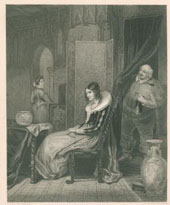
Flagstaff and Anne Page (aka Mrs Ford)
Attribution on print:"H. Bourne, Engraver"
Size of Bourne engraving: 7.6 x 9.3 in (19.3 x 23.7 cm)
Estimated date engraved: before 1872
Source of print: Art Journal, May, 1853 (pub. George Virtue.) Also appears in Imperial Edition of The Works of Shakespeare, Volume 1, by Charles Knight, 1873 (Virtue & Yorston, New York)
Printed by: unknown
Title of source painting: unknown
Painter: George Clint
Probable date of source painting: 1831
Current location of painting: unknown
Note: Engraving represents act 3, scene 3 in Shakespeare's Merry Wives of Windsor. Some examples of the print are known labeled Falstaff and Mrs. Ford . The British Museum acquired a copy in 1872.
Rarity 2 based on sales appearances (on a scale of 1 to 8). This print is very common (offered about one time per month).
Size of Bourne engraving: 7.6 x 9.3 in (19.3 x 23.7 cm)
Estimated date engraved: before 1872
Source of print: Art Journal, May, 1853 (pub. George Virtue.) Also appears in Imperial Edition of The Works of Shakespeare, Volume 1, by Charles Knight, 1873 (Virtue & Yorston, New York)
Printed by: unknown
Title of source painting: unknown
Painter: George Clint
Probable date of source painting: 1831
Current location of painting: unknown
Note: Engraving represents act 3, scene 3 in Shakespeare's Merry Wives of Windsor. Some examples of the print are known labeled Falstaff and Mrs. Ford . The British Museum acquired a copy in 1872.
Rarity 2 based on sales appearances (on a scale of 1 to 8). This print is very common (offered about one time per month).
| Sales statistics since Jan. 1, 2007 |
| This print has appeared for sale 294 times and has sold 8 times. |
| Offer prices have ranged from $1.47 to $269.00 |
| Average sale price: $10.71 |
| Highest sale price ever recorded: $19.95 |
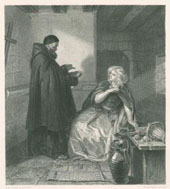
Juliet in the Cell of Friar Lawrence
Attribution on print:"H. Bourne, Sculpt."
Size of Bourne engraving: 7.8 x 8.7 in (19.8 x 22.2 cm)
Estimated date engraved: before 1882
Source of print: Art Journal, February, 1873. Also in Art and Artists of Our Time, vol. III; also found in A Collection of Scenes and Characters from Famous Paintings by Eminent Artists Each Subject being Chosen by the Artist Himself as a Work of Art Entitling it to a Place in the Royal Academy Exhibitions As well as Authentic Character Portraits of Celebrated Shakespearean Actors. With Descriptive Text by the Eminent Shakespearean Scholars F.J. Furnivall, LL.D, Horace Howard Furness, Litt. D., Edward Dowden, LL.D. And other authorities. Also appears in Also appears in Imperial Edition of The Works of Shakespeare, Volume 2, by Charles Knight, 1873 (Virtue & Yorston, New York)
Printed by: Blackie & Son
Title of source painting: unknown
Painter: Edward Matthew Ward
Probable date of source painting: unknown
Current location of painting: unknown
Note: Froma painting depicting a scene in Shalespeare's Romeo and Juliet.One source says that A Collection of Scenes and Characters from Famous Paintings shows this print titled as 'Juliet and Friar Laurence'. The British Museum acquired a copy of the engraving in 2001 supposedly from the 1873 Art Journal. The original painting was exhibited at the Royal Academy in 1867. It sold at Christie's Arp 21, 1894.
Rarity 1 based on sales appearances (on a scale of 1 to 8). This print is extremely common and continuously available (offered twice per month or more).
Size of Bourne engraving: 7.8 x 8.7 in (19.8 x 22.2 cm)
Estimated date engraved: before 1882
Source of print: Art Journal, February, 1873. Also in Art and Artists of Our Time, vol. III; also found in A Collection of Scenes and Characters from Famous Paintings by Eminent Artists Each Subject being Chosen by the Artist Himself as a Work of Art Entitling it to a Place in the Royal Academy Exhibitions As well as Authentic Character Portraits of Celebrated Shakespearean Actors. With Descriptive Text by the Eminent Shakespearean Scholars F.J. Furnivall, LL.D, Horace Howard Furness, Litt. D., Edward Dowden, LL.D. And other authorities. Also appears in Also appears in Imperial Edition of The Works of Shakespeare, Volume 2, by Charles Knight, 1873 (Virtue & Yorston, New York)
Printed by: Blackie & Son
Title of source painting: unknown
Painter: Edward Matthew Ward
Probable date of source painting: unknown
Current location of painting: unknown
Note: Froma painting depicting a scene in Shalespeare's Romeo and Juliet.One source says that A Collection of Scenes and Characters from Famous Paintings shows this print titled as 'Juliet and Friar Laurence'. The British Museum acquired a copy of the engraving in 2001 supposedly from the 1873 Art Journal. The original painting was exhibited at the Royal Academy in 1867. It sold at Christie's Arp 21, 1894.
Rarity 1 based on sales appearances (on a scale of 1 to 8). This print is extremely common and continuously available (offered twice per month or more).
| Sales statistics since Jan. 1, 2007 |
| This print has appeared for sale 406 times and has sold 9 times. |
| Offer prices have ranged from $0.99 to $204.00 |
| Average sale price: $6.69 |
| Highest sale price ever recorded: $12.95 |
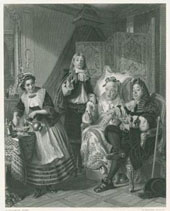
Le Malade Imaginaire (aka Argan and Doctor Diaforius)
Attribution on print:"H. Bourne, Sculpt."
Size of Bourne engraving: 7.3 x 9.1 in (18.5 x 23.2 cm)
Estimated date engraved: about 1853
Source of print: reportedly from the Art Journal, May, 1871
Printed by: D. Appleton & Co, New York
Title of source painting: unknown
Painter: Abraham Solomon
Probable date of source painting: unknown
Current location of painting: unknown
Note: A scene from the three-act play of the same name by Moliere which premiered in Paris in 1673; also known as The Hypochondriac. The original painting was exhibited at the Royal Academy of Arts in 1861. It was sold at Christie's in London Jun 29, 1895 and again Jun 4, 1982. The British Museum acquired an unlettered proof impression of the engraving in 1913.
Rarity 1 based on sales appearances (on a scale of 1 to 8). This print is extremely common and continuously available (offered twice per month or more).
Size of Bourne engraving: 7.3 x 9.1 in (18.5 x 23.2 cm)
Estimated date engraved: about 1853
Source of print: reportedly from the Art Journal, May, 1871
Printed by: D. Appleton & Co, New York
Title of source painting: unknown
Painter: Abraham Solomon
Probable date of source painting: unknown
Current location of painting: unknown
Note: A scene from the three-act play of the same name by Moliere which premiered in Paris in 1673; also known as The Hypochondriac. The original painting was exhibited at the Royal Academy of Arts in 1861. It was sold at Christie's in London Jun 29, 1895 and again Jun 4, 1982. The British Museum acquired an unlettered proof impression of the engraving in 1913.
Rarity 1 based on sales appearances (on a scale of 1 to 8). This print is extremely common and continuously available (offered twice per month or more).
| Sales statistics since Jan. 1, 2007 |
| This print has appeared for sale 368 times and has sold 18 times. |
| Offer prices have ranged from $0.00 to $900.00 |
| Average sale price: $16.51 |
| Highest sale price ever recorded: $35.00 |
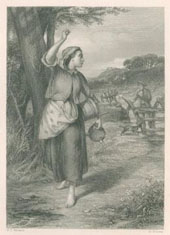
Robin & Makyne
Attribution on print:"H. Bourne"
Size of Bourne engraving: 4.3 x 6 in (10.8 x 15.2 cm)
Estimated date engraved: unknown
Source of print: unknown
Printed by: Virtue & Co.
Title of source painting: unknown
Painter: William Fleming Vallance
Probable date of source painting: unknown
Current location of painting: unknown
Note: The original painting was inspired by a Scottish poem by Robert Henryson (1425-1500) titled, Robin and Makyne.
Rarity unknown (never seen offered for sale). This print is exceedingly rare.
Size of Bourne engraving: 4.3 x 6 in (10.8 x 15.2 cm)
Estimated date engraved: unknown
Source of print: unknown
Printed by: Virtue & Co.
Title of source painting: unknown
Painter: William Fleming Vallance
Probable date of source painting: unknown
Current location of painting: unknown
Note: The original painting was inspired by a Scottish poem by Robert Henryson (1425-1500) titled, Robin and Makyne.
Rarity unknown (never seen offered for sale). This print is exceedingly rare.
| Sales statistics since Jan. 1, 2007 |
| I have not seen this engraving offered for sale anywhere. |
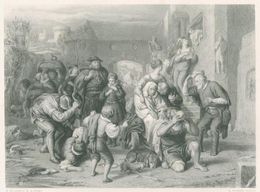
The Seven Ages of Man
Attribution on print:"H. Bourne, Sculpt."
Size of Bourne engraving: 9.4 x 6.9 in (23.8 x 17.5 cm)
Estimated date engraved: unknown
Source of print: Art Journal, July, 1874. Also appears in Imperial Edition of The Works of Shakespeare, Volume 1, by Charles Knight, 1873 (Virtue & Yorston, New York)
Printed by: Virtue & Co.
Title of source painting: The Seven Ages of Man: 'All the World's a Stage'
Painter: William Mulready
Probable date of source painting: 1838
Current location of painting: unknown
Note: Engraving represents scene in Shakespeare's As You Like It.
Rarity 4 based on sales appearances (on a scale of 1 to 8). This print is somewhat common (offered about three times per year).
Size of Bourne engraving: 9.4 x 6.9 in (23.8 x 17.5 cm)
Estimated date engraved: unknown
Source of print: Art Journal, July, 1874. Also appears in Imperial Edition of The Works of Shakespeare, Volume 1, by Charles Knight, 1873 (Virtue & Yorston, New York)
Printed by: Virtue & Co.
Title of source painting: The Seven Ages of Man: 'All the World's a Stage'
Painter: William Mulready
Probable date of source painting: 1838
Current location of painting: unknown
Note: Engraving represents scene in Shakespeare's As You Like It.
Rarity 4 based on sales appearances (on a scale of 1 to 8). This print is somewhat common (offered about three times per year).
| Sales statistics since Jan. 1, 2007 |
| This print has appeared for sale 58 times and has sold 7 times. |
| Offer prices have ranged from $1.47 to $70.00 |
| Average sale price: $15.64 |
| Highest sale price ever recorded: $49.95 |
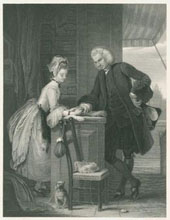
Yorick and the Grisette
Attribution on print:"H. Bourne, Engraver"
Size of Bourne engraving: 7.4 x 9.7 in (18.8 x 24.6 cm)
Estimated date engraved: about 1852
Source of print: Art Journal, February, 1852 (pub. George Virtue.). That version lacks text concerning appearance of the picture in the Vernon Gallery. The Wilkinson printing version comes from a different unknown source, likely dated about 1853.
Printed by: H. Wilkinson
Title of source painting: Yorick and the Grisette
Painter: Gilbert Stuart Newton
Probable date of source painting: 1847
Current location of painting: Tate Gallery
Note: The British Museum acquired three copies of the Wilkinson printing in 1853, 1855 and 1900. The 1853 print is signed on the back in pencil by Bourne. 'Grisette' was a 18th century term for a part-time prostitute. The painting was exhibited in London in 1830 and represents a scene from A Sentimental Journey Through France and Italy, a 1768 novel by Laurence Sterne.
Rarity 2 based on sales appearances (on a scale of 1 to 8). This print is very common (offered about one time per month).
Size of Bourne engraving: 7.4 x 9.7 in (18.8 x 24.6 cm)
Estimated date engraved: about 1852
Source of print: Art Journal, February, 1852 (pub. George Virtue.). That version lacks text concerning appearance of the picture in the Vernon Gallery. The Wilkinson printing version comes from a different unknown source, likely dated about 1853.
Printed by: H. Wilkinson
Title of source painting: Yorick and the Grisette
Painter: Gilbert Stuart Newton
Probable date of source painting: 1847
Current location of painting: Tate Gallery
Note: The British Museum acquired three copies of the Wilkinson printing in 1853, 1855 and 1900. The 1853 print is signed on the back in pencil by Bourne. 'Grisette' was a 18th century term for a part-time prostitute. The painting was exhibited in London in 1830 and represents a scene from A Sentimental Journey Through France and Italy, a 1768 novel by Laurence Sterne.
Rarity 2 based on sales appearances (on a scale of 1 to 8). This print is very common (offered about one time per month).
| Sales statistics since Jan. 1, 2007 |
| This print has appeared for sale 206 times and has sold 16 times. |
| Offer prices have ranged from $0.99 to $450.00 |
| Average sale price: $28.89 |
| Highest sale price ever recorded: $300.00 |